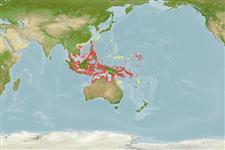>
Eupercaria/misc (Various families in series Eupercaria) >
Labridae (Wrasses) > Corinae
Etymology: Halichoeres: Greek, als, alis = salt + Greek, choiros = pig (Ref. 45335).
More on author: Walbaum.
Environment: milieu / climate zone / depth range / distribution range
Ökologie
seewasser riff-verbunden; tiefenbereich 1 - 15 m (Ref. 90102). Tropical; 32°N - 12°S, 99°E - 172°E
Western Pacific: Philippines to New Guinea, north to the Yaeyama Islands, south to Flores, Indonesia. Palau in Micronesia.
Size / Gewicht / Alter
Maturity: Lm ? range ? - ? cm
Max length : 13.0 cm TL Männchen/unbestimmt; (Ref. 34765)
Rückenflossenstacheln (insgesamt) : 9; Rückenflossenweichstrahlen (insgesamt) : 13; Afterflossenstacheln: 3; Afterflossenweichstrahlen: 13. Males recognized by the grey-looking head when seen in natural light. Body with lined pattern until female stage. Males with orange spots along scale rows (Ref. 48636).
Found in coral-rich lagoon and inner channel reefs to at least 15 m depth (Ref. 34765); in mixed coral and algae habitats (Ref. 48636). May be found solitary or in pairs (Ref. 90102). Feeds on small benthic invertebrates.
Life cycle and mating behavior
Maturities | Fortpflanzung | Spawnings | Egg(s) | Fecundities | Larven
Distinct pairing during breeding (Ref. 205).
Myers, R.F., 1999. Micronesian reef fishes. A comprehensive guide to the coral reef fishes of Micronesia. Coral Graphics, Barrigada, Guam. 216 p. (Ref. 34765)
IUCN Rote Liste Status (Ref. 130435)
Bedrohung für Menschen
Harmless
Nutzung durch Menschen
Tools
Zusatzinformationen
Download XML
Internet Quellen
Estimates based on models
Preferred temperature (Ref.
123201): 27.4 - 29.3, mean 28.8 °C (based on 1695 cells).
Phylogenetic diversity index (Ref.
82804): PD
50 = 0.5000 [Uniqueness, from 0.5 = low to 2.0 = high].
Bayesian length-weight: a=0.00955 (0.00451 - 0.02020), b=3.09 (2.92 - 3.26), in cm total length, based on LWR estimates for this Genus-body shape (Ref.
93245).
Trophic level (Ref.
69278): 3.5 ±0.37 se; based on food items.
Widerstandsfähigkeit (Ref.
120179): hoch, Verdopplung der Population dauert weniger als 15 Monate. (Preliminary K or Fecundity.).
Fishing Vulnerability (Ref.
59153): Low vulnerability (10 of 100).
Nutrients (Ref.
124155): Calcium = 101 [60, 176] mg/100g; Iron = 0.766 [0.437, 1.437] mg/100g; Protein = 18.5 [15.6, 20.7] %; Omega3 = 0.151 [0.095, 0.245] g/100g; Selenium = 19.8 [11.4, 37.1] μg/100g; VitaminA = 153 [47, 565] μg/100g; Zinc = 1.82 [1.23, 2.88] mg/100g (wet weight);
